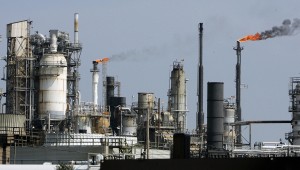 West Texas Intermediate and Brent crude extended declines into an eight week after the United Arab Emirates said it will stick with plans to expand production in the next two years despite a global supply glut that has slashed the market by more than a half. Expectations for a jump in US crude oil supplies offset a hefty gain in Chinese crude imports. Natural gas rebounded from the lowest in two years.
West Texas Intermediate and Brent crude extended declines into an eight week after the United Arab Emirates said it will stick with plans to expand production in the next two years despite a global supply glut that has slashed the market by more than a half. Expectations for a jump in US crude oil supplies offset a hefty gain in Chinese crude imports. Natural gas rebounded from the lowest in two years.
US crude for delivery in February slid 3.00% to $44.69 per barrel by 13:42 GMT, having earlier fallen to $44.20, the lowest since April 2009. The contract fell 4.74% yesterday to $46.07, the lowest settlement since the same month.
Meanwhile on the ICE, Brent for delivery in February dropped 3.82% to $45.62 per barrel, with prices earlier dropping to $45.19 a barrel, the lowest since March 2009. The European crude benchmark slid 5.35% yesterday to $47.43, settling at a premium of $1.36 to its US counterpart. The gap narrowed to $0.93 on Tuesday.
Oil prices tumbled to the lowest in almost six years on Monday after Goldman Sachs and Societe Generale cut their oil price outlook for the year. Goldman predicted a further slump in prices before US producers cut investments, which in turn will ease a supply glut, allowing the market to balance itself out. Dutch bank ABN Amro also trimmed its outlook, while Australia’s Macquarie bank expects Brent to hover around $50-$60 per barrel in the first half, and jump to $85 in late 2015.
Goldman predicted US crude will trade at $39 and $65 per barrel in six and twelve months, respectively, compared to previous projections for $75 and $80, while the outlook for Brent was slashed to $43 and $70 from $85 and $90 earlier. For the first quarter, WTI is projected at $41 and Brent at $42, the bank said.
OPEC determination
Meanwhile, the United Arab Emirates, OPEC’s fifth-largest producer, reaffirmed its plans to expand output capacity to 3.5 million barrels per day in 2017, ignoring a global supply overhang that has sent prices falling by 60% since a June peak. The country pumped 2.7 million bpd in December and currently has a capacity of 3 million bpd, according to estimates by Bloomberg.
UAE Energy Minister Suhail Al Mazrouei said yesterday: “In this time of unstable oil prices, we are showing in Abu Dhabi and across the country that we remain dedicated to reach our long-term production goals. Our investments remain there.”
OPEC, which accounts for about 40% of global supply, reached a collective decision on November 27th to keep its production quota unchanged, ignoring smaller members’ appeals to lower output in order to cushion a steep price drop. According to a Bloomberg survey, the oil cartel pumped 30.24 million bpd of crude in December, lower than November but still exceeding its official target.
Major OPEC producers have underscored their determination to protect market share and pump at the same pace, attributing the global supply overhang to record-high US production that reached 9.14 million bpd in the week through December 12th, 2014, and has remained an inch below that level ever since. Qatar estimates that the market swims in an excess of 2 million barrels per day.
“It will all depend on what we see in this quarter and the next quarter,” Mazroui said in response to questions to when oil would stabilize. “Most probably we are going to wait until our meeting in June, and lets not jump to conclusions.”
China imports
Some support was drawn as China’s exports jumped by an annualized 9.7% in December, compared to forecasts for 6.8%, while imports fell by 2.4%, whereas analysts had projected a much steeper 7.4% drop. As a result, China’s trade surplus narrowed to $49.60 billion from $54.47 billion.
In terms of crude oil, the Asian nation imported a record amount of the commodity, with inbound shipments surging 19.5% from November to 30.4 million tons. Crude imports surged for the first time above 7 million barrels per day in December, while for the entire year they rose 9.5% to 6.2 million barrels per day.
However, the Chinese data was offset by analysts early estimates that US crude oil inventories probably rose by 1.75 million barrels in the week ended January 9th to 384.1 million. Distillate fuel inventories, which include diesel and heating oil, probably jumped by 2.1 million barrels last week, while gasoline inventories likely expanded by 3.75 million.
Last week’s report showed an unexpected decline in crude stockpiles of 3.062 million barrels, but supplies in Cushing, Oklahoma jumped and both fuel categories surged by a combined record of over 19 million barrels. Industry group the American Petroleum Institute will release its separate private data later today.
Natural gas
Natural gas pared steep overnight losses on Tuesday after the energy source dropped yesterday to its lowest in more than two years.
Natural gas for delivery in February traded 2.72% higher at $2.871 per million British thermal units at 13:45 GMT, having shifted in a daily range of $2.918-$2.795. The energy source plummeted 5.13% on Monday to $2.795, but not before it reached its lowest since September 20th 2012 at $2.783.
According to NatGasWeather.com, US natural gas demand will be high-to-moderate compared to normal through January 19th, with a slightly warmer trend early next week, turning neutral towards the end of it.
Colder Canadian air will maintain its position over the Great Lakes and interior Northeast during the next two to three days, while temperatures in the southern US will push higher and reach 50s and 60s.
A weather system will move across the Southwest pouring down snow and rain over certain areas before it flows into northern Texas and the Plains on Wednesday. The system will bring milder temperatures over the regions and will also clear the way for a strong Pacific flow expected later this week.
A series of weather systems will travel across the country and each of them is expected to warm up temperatures before it arrives and leaves behind a quick blast of colder readings.
A stronger weather system will flow into the northern US, bringing areas of snow and rain on Sunday and Monday, NatGasWeather.com estimated.
Overall temperatures will go above the usual over the majority of the US as the severe cold Canadian air will be pushed out of the US late this week. The higher readings are expected to last until late next week as weather systems travel the length of the country with areas of rain and snow.
Colder Canadian systems are projected to flow into parts of the northern US around 23-24th. However, sub-freezing readings are not expected to reach very far south, leaving the central and southern US quite mild.





